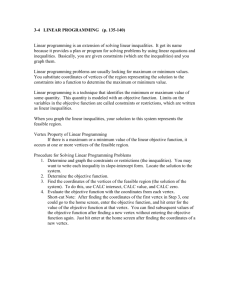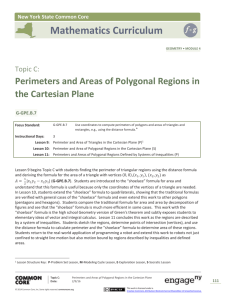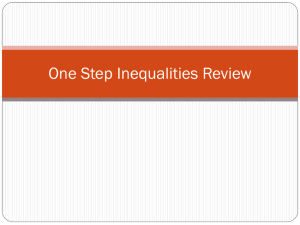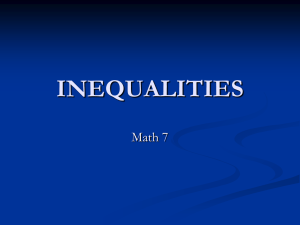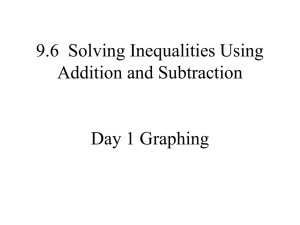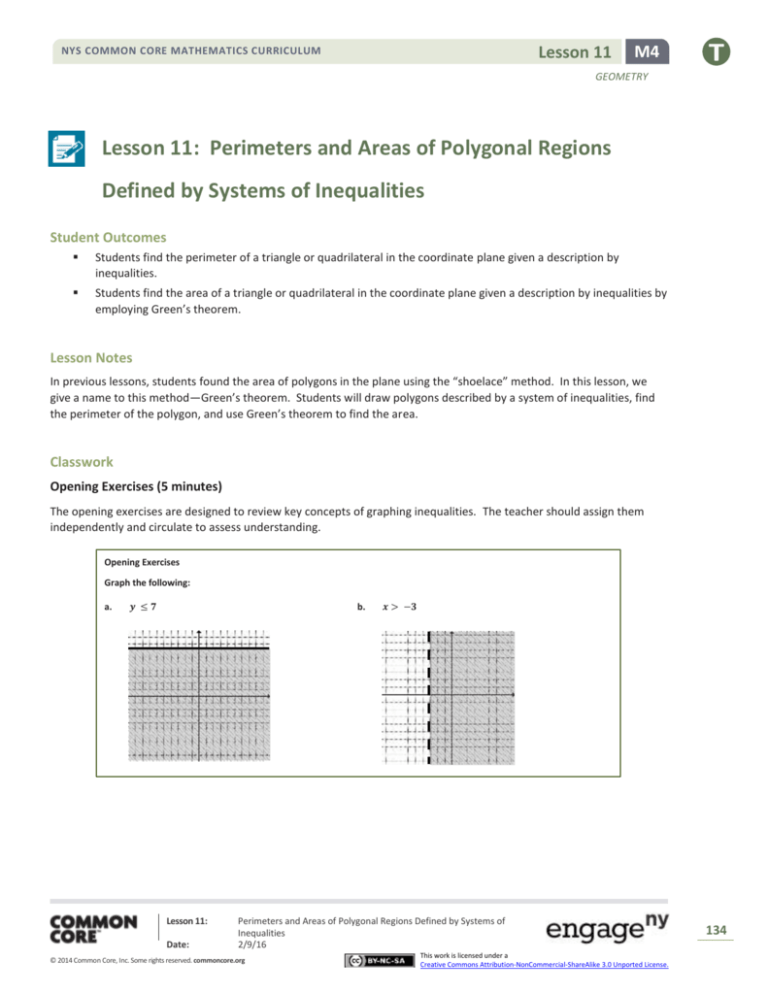
Lesson 11
NYS COMMON CORE MATHEMATICS CURRICULUM
M4
GEOMETRY
Lesson 11: Perimeters and Areas of Polygonal Regions
Defined by Systems of Inequalities
Student Outcomes
Students find the perimeter of a triangle or quadrilateral in the coordinate plane given a description by
inequalities.
Students find the area of a triangle or quadrilateral in the coordinate plane given a description by inequalities by
employing Green’s theorem.
Lesson Notes
In previous lessons, students found the area of polygons in the plane using the “shoelace” method. In this lesson, we
give a name to this method—Green’s theorem. Students will draw polygons described by a system of inequalities, find
the perimeter of the polygon, and use Green’s theorem to find the area.
Classwork
Opening Exercises (5 minutes)
The opening exercises are designed to review key concepts of graphing inequalities. The teacher should assign them
independently and circulate to assess understanding.
Opening Exercises
Graph the following:
a.
𝒚 ≤𝟕
b.
Lesson 11:
Date:
𝒙 > −𝟑
Perimeters and Areas of Polygonal Regions Defined by Systems of
Inequalities
2/9/16
© 2014 Common Core, Inc. Some rights reserved. commoncore.org
This work is licensed under a
Creative Commons Attribution-NonCommercial-ShareAlike 3.0 Unported License.
134
Lesson 11
NYS COMMON CORE MATHEMATICS CURRICULUM
M4
GEOMETRY
𝟏
𝟐
𝒚< 𝒙−𝟒
c.
d.
𝟐
𝟑
𝒚 ≥− 𝒙+𝟓
Example 1 (10 minutes)
Example 1
A parallelogram with base of length 𝒃 and height 𝒉 can be situated in the coordinate
plane as shown. Verify that the shoelace formula gives the area of the parallelogram
as 𝒃𝒉.
What is the area of a parallelogram?
The distance from the 𝑦-axis to the top left vertex is some number 𝑥. What are
the coordinates of that vertex?
𝑏 units
So what is the length of the top side?
They must be equal.
What is the length of the bottom side?
(𝑥, ℎ)
Can you determine the coordinates of the top right vertex? What do we know
about opposite sides of a parallelogram?
Base × height
𝑏 units
Scaffolding:
If students are confused
about the coordinates
provide either a graph of a
parallelogram with the
coordinates showing
(more concrete) or a graph
with at least tick marks so
that students may count
the distances for base and
height.
The bottom side starts at the origin (where 𝑥 = 0); where does the top side
start? Hint: What is the 𝑥-coordinate of the top left vertex?
𝑥
Lesson 11:
Date:
Perimeters and Areas of Polygonal Regions Defined by Systems of
Inequalities
2/9/16
© 2014 Common Core, Inc. Some rights reserved. commoncore.org
This work is licensed under a
Creative Commons Attribution-NonCommercial-ShareAlike 3.0 Unported License.
135
Lesson 11
NYS COMMON CORE MATHEMATICS CURRICULUM
M4
GEOMETRY
So if the length is 𝑏 units, what would the 𝑥-coordinate of the top right vertex be?
So what are the coordinates of the top right vertex?
(𝑥 + 𝑏, ℎ)
List the coordinates of the vertices starting at the origin and moving clockwise.
𝑥+𝑏
(0, 0), (𝑥, ℎ), (𝑥 + 𝑏, ℎ), and (𝑏, 0)
Use the shoelace formula (Green’s theorem) to find the area moving counterclockwise.
1
2
1
2
(0 ∙ 0 + 𝑏 ∙ ℎ + (𝑥 + 𝑏) ∙ ℎ + 𝑥 ∙ 0 − 0 ∙ 𝑏 − 0(𝑥 + 𝑏) − ℎ ∙ 𝑥 − ℎ ∙ 0) =
1
(𝑏 ∙ ℎ + 𝑥 ∙ ℎ + 𝑏 ∙ ℎ − ℎ ∙ 𝑥) = (2(𝑏 ∙ ℎ)) = 𝑏 ∙ ℎ
2
Example 2 (5 minutes)
Example 2
A triangle with base 𝒃 and height 𝒉 can be situated in the coordinate plane as
shown. According to Green’s theorem, what is the area of the triangle?
MP.1
Let students try to do this problem on their own following the steps used above. Scaffold with the following questions as
necessary.
What is the area of a triangle?
(𝑥, ℎ)
(0,0), (𝑥, ℎ), and (𝑏, 0)
Use the shoelace formula (Green’s theorem) to find the area moving counterclockwise.
base × height
List the coordinates of the vertices starting at the origin and moving clockwise.
2
Let the distance from the 𝑦-axis to the top vertex be some number 𝑥. What are the coordinates of that vertex?
1
1
2
1
(0 ∙ 0 + 𝑏 ∙ ℎ + 𝑥 ∙ 0 − 0 ∙ 𝑏 − 0 ∙ 𝑥 − ℎ ∙ 0) = (𝑏 ∙ ℎ)
2
Summarize what you have learned so far with a partner.
We have verified well known formulas using Green’s theorem.
Lesson 11:
Date:
Perimeters and Areas of Polygonal Regions Defined by Systems of
Inequalities
2/9/16
© 2014 Common Core, Inc. Some rights reserved. commoncore.org
This work is licensed under a
Creative Commons Attribution-NonCommercial-ShareAlike 3.0 Unported License.
136
Lesson 11
NYS COMMON CORE MATHEMATICS CURRICULUM
M4
GEOMETRY
Exercises 1–2 (15 minutes)
In this exercise, students work with a partner to compute the area and perimeter of a quadrilateral region in the plane
defined by a set of inequalities. Have each student do one problem, parts (a) and (b), then check in with their partner
and check each other’s work. Then do parts (c) and (d) and check in again. Students should graph the inequalities, solve
pairs of inequalities to find the coordinates of the vertices, use the distance formula to find the perimeter, and apply the
shoelace formula (Green’s theorem) to find the area.
Exercises 1–2
1.
A quadrilateral region is defined by the system of inequalities below:
𝒚≤ 𝒙+𝟔
𝒚 ≤ −𝟐𝒙 + 𝟏𝟐
𝒚 ≥ 𝟐𝒙 − 𝟒
a.
Sketch the region.
b.
Determine the vertices of the quadrilateral.
𝒚 ≥ −𝒙 + 𝟐
(𝟐, 𝟖), (𝟒, 𝟒), (𝟐, 𝟎), (−𝟐, 𝟒). Ask students how they can verify the intersection points. (By showing that each
set of coordinates satisfies the equations of both intersecting lines that determine the vertex.)
c.
Find the perimeter of the quadrilateral region.
≈ 𝟐𝟎. 𝟐𝟔 units
d.
Find the area of the quadrilateral region.
𝟐𝟒 square units
2.
A quadrilateral region is defined by the system of inequalities below:
𝒚≤ 𝒙+𝟓
a.
𝒚≥ 𝒙−𝟒
𝒚≤𝟒
𝟓
𝟒
𝒚≥ − 𝒙−𝟒
Sketch the region.
Lesson 11:
Date:
Perimeters and Areas of Polygonal Regions Defined by Systems of
Inequalities
2/9/16
© 2014 Common Core, Inc. Some rights reserved. commoncore.org
This work is licensed under a
Creative Commons Attribution-NonCommercial-ShareAlike 3.0 Unported License.
137
Lesson 11
NYS COMMON CORE MATHEMATICS CURRICULUM
M4
GEOMETRY
b.
Determine the vertices of the quadrilateral.
(−𝟒, 𝟏), (−𝟏, 𝟒), (𝟖, 𝟒), (𝟎, −𝟒)
c.
Which quadrilateral is defined by these inequalities? How can you prove your conclusion?
A trapezoid. We can prove that one pair of opposite sides is parallel.
d.
Find the perimeter of the quadrilateral region.
≈ 𝟑𝟎. 𝟗𝟓 units
e.
Find the area of the quadrilateral region.
𝟓𝟎 square units
Closing (2 minutes)
Gather the entire class and ask these questions. Have students share answers.
The shoelace method for finding the area of a polygon is also known as?
Green’s theorem
How did we verify the formulas for the area of a parallelogram and triangle?
We used Green’s theorem with variables as coordinates to verify the known formulas.
Exit Ticket (8 minutes)
Lesson 11:
Date:
Perimeters and Areas of Polygonal Regions Defined by Systems of
Inequalities
2/9/16
© 2014 Common Core, Inc. Some rights reserved. commoncore.org
This work is licensed under a
Creative Commons Attribution-NonCommercial-ShareAlike 3.0 Unported License.
138
Lesson 11
NYS COMMON CORE MATHEMATICS CURRICULUM
M4
GEOMETRY
Name
Date
Lesson 11: Perimeters and Areas of Polygonal Regions Defined by
Systems of Inequalities
Exit Ticket
A quadrilateral region is defined by the system of inequalities below:
𝑦≤5
𝑦 ≥ −3
1.
Sketch the region.
2.
Determine the coordinates of the vertices.
3.
Find the area of the quadrilateral region.
Lesson 11:
Date:
𝑦 ≤ 2𝑥 + 1
𝑦 ≥ 2𝑥 − 7
Perimeters and Areas of Polygonal Regions Defined by Systems of
Inequalities
2/9/16
© 2014 Common Core, Inc. Some rights reserved. commoncore.org
This work is licensed under a
Creative Commons Attribution-NonCommercial-ShareAlike 3.0 Unported License.
139
Lesson 11
NYS COMMON CORE MATHEMATICS CURRICULUM
M4
GEOMETRY
Exit Ticket Sample Solutions
1.
A quadrilateral region is defined by the system of inequalities below:
𝒚≤𝟓
𝒚 ≥ −𝟑
a.
Sketch the region.
b.
Determine the coordinates of the vertices.
𝒚 ≤ 𝟐𝒙 + 𝟏
𝒚 ≥ 𝟐𝒙 − 𝟕
(𝟐, 𝟓), (𝟔, 𝟓), (𝟐, −𝟑), (−𝟐, −𝟑)
c.
Find the area of the quadrilateral region.
𝟑𝟐 square units
Problem Set Sample Solutions
For Problems 1–2 below, identify the system of inequalities that defines the region shown.
𝒚 ≥ −𝟏,
𝟐
𝟑
𝒙 ≥ −𝟏, 𝒚 ≤ − 𝒙 +
Lesson 11:
Date:
𝟏𝟑
𝟑
Perimeters and Areas of Polygonal Regions Defined by Systems of
Inequalities
2/9/16
© 2014 Common Core, Inc. Some rights reserved. commoncore.org
This work is licensed under a
Creative Commons Attribution-NonCommercial-ShareAlike 3.0 Unported License.
140
Lesson 11
NYS COMMON CORE MATHEMATICS CURRICULUM
M4
GEOMETRY
2.
𝟏
𝟐
𝒚≥ 𝒙−𝟑
𝟓
𝟔
𝒚≤ − 𝒙+𝟓
𝟏
𝟒
𝒚≤ 𝒙+𝟓
𝒚 ≥ −𝟒𝒙 − 𝟏𝟐
For Problems 3–5 below, a triangular or quadrilateral region is defined by the system of inequalities listed.
3.
a.
Sketch the region.
b.
Determine the coordinates of the vertices.
c.
Find the perimeter of the region rounded to the nearest hundredth if necessary.
d.
Find the area of the region rounded to the nearest tenth if necessary.
𝟖𝒙 − 𝟗𝒚 ≥ −𝟐𝟐
𝒙 + 𝒚 ≤ 𝟏𝟎
𝟓𝒙 − 𝟏𝟐𝒚 ≤ −𝟏
a.
b.
(𝟒, 𝟔),(𝟕, 𝟑),(−𝟓, −𝟐)
c.
≈ 𝟐𝟗. 𝟐𝟖 units
d.
𝟐𝟓. 𝟓 square units
Lesson 11:
Date:
Perimeters and Areas of Polygonal Regions Defined by Systems of
Inequalities
2/9/16
© 2014 Common Core, Inc. Some rights reserved. commoncore.org
This work is licensed under a
Creative Commons Attribution-NonCommercial-ShareAlike 3.0 Unported License.
141
Lesson 11
NYS COMMON CORE MATHEMATICS CURRICULUM
M4
GEOMETRY
4.
𝒙 + 𝟑𝒚 ≥ 𝟎
𝟒𝒙 − 𝟑𝒚 ≥ 𝟎
𝟐𝒙 + 𝒚 ≤ 𝟏𝟎
a.
5.
b.
(𝟑, 𝟒), (𝟔, −𝟐), (𝟎, 𝟎)
c.
≈ 𝟏𝟖. 𝟎𝟑 units
d.
𝟏𝟓 square units
𝟐𝒙 − 𝟓𝒚 ≥ −𝟏𝟒
𝟑𝒙 + 𝟐𝒚 ≤ 𝟏𝟕
𝟐𝒙 − 𝒚 ≤ 𝟗
𝒙+𝒚≥ 𝟎
a.
b.
(𝟑, 𝟒), (𝟓, 𝟏), (𝟑, −𝟑), (−𝟐, 𝟐)
c.
≈ 𝟐𝟎. 𝟓𝟑 units
d.
𝟐𝟒. 𝟓 square units
Lesson 11:
Date:
Perimeters and Areas of Polygonal Regions Defined by Systems of
Inequalities
2/9/16
© 2014 Common Core, Inc. Some rights reserved. commoncore.org
This work is licensed under a
Creative Commons Attribution-NonCommercial-ShareAlike 3.0 Unported License.
142

